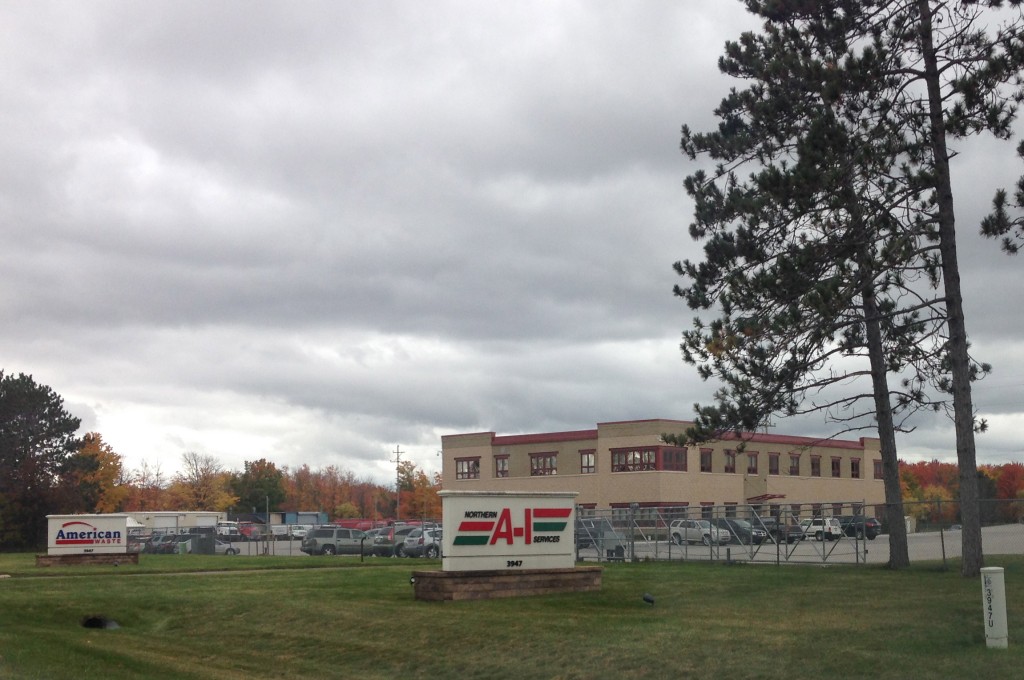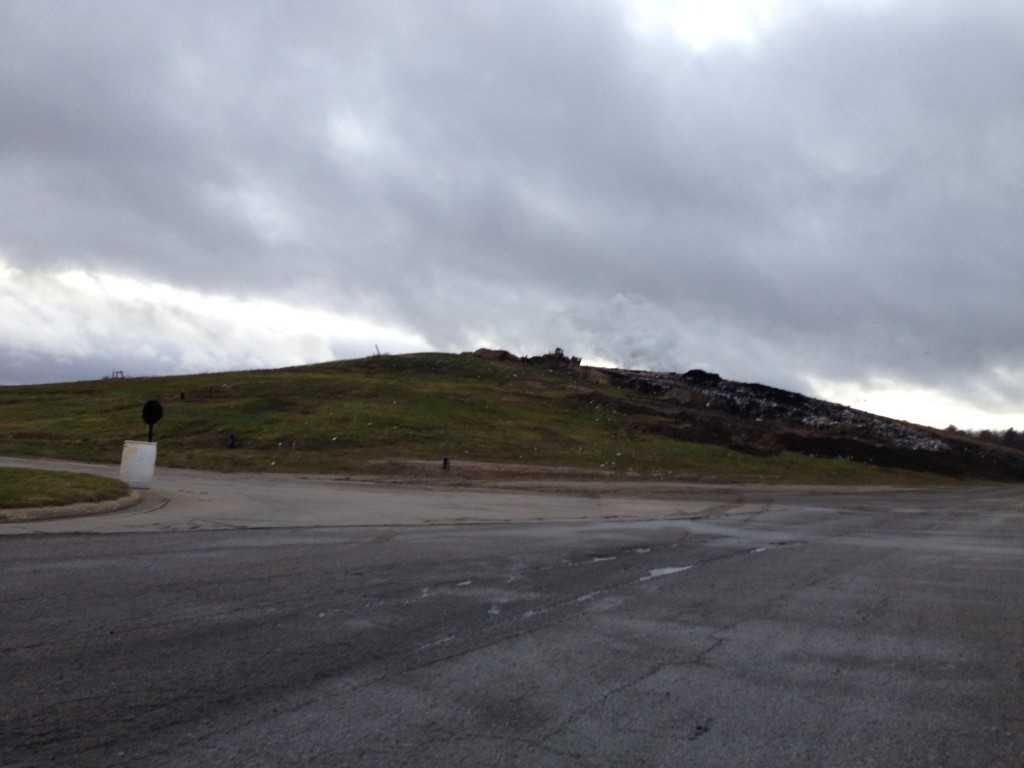

Waste disposal company A-1 Northern in Kalkaska received over 400 tons of frack wastes from Pennsylvania. Photo by Ban Michigan Fracking.
We’ve known this for a while now, but it’s time to get it out there: Michigan is fast becoming a frack waste state.
Part of the story is that Michigan facilities are taking in wastes from other states.
The other part is that the frack industry generated huge amounts of wastes from Michigan frack wells.
The startling news about out of state frack waste is that over 2,200 tons of frack waste from Pennsylvania have come to Michigan in three counties: Wayne, Monroe and Kalkaska.
We learned of this by searching the State of Pennsylvania’s Department of Environmental Protection’s “oil and gas reporting” website. That the State of Michigan Dept of Environmental Quality Office of Oil Gas and Minerals neither tracks the disposal of frack wastes–generated in Michigan or elsewhere–nor provides the information to the public as Pennsylvania does, is troubling.
The Michigan facilities are headquartered in the communities of Van Buren Township, Kalkaska, Detroit and Erie, but exact disposal facilities are not known for the Kalkaska wastes.
Van Buren Township: The Belleville-area twin processing and landfill facilities now owned by US Ecology, called Michigan Disposal and Wayne Disposal, accepted 20.42 tons of drill cuttings (which is TENORM: Technologically Enhanced Naturally Occuring Radioactive Materials) from a Greene County, Pennsylvania horizontal well in 2010 (PA reported it in 2014). And another 315.75 tons of “flowback fracturing sand” from several horizontal wells in Greene County were brought to Wayne Disposal at various times from 2010 through 2013 (but not reported by PA until 2014). See our four stories earlier this year on this website about Michigan Disposal/Wayne Disposal. We do not yet know the final disposition of the radioactive sludge approved for shipment to Wayne Disposal. Story 1, Story 2, Story 3, Story 4.
Kalkaska: Over 400 tons of “flowback fracturing sand” landed in Kalkaska County, according to the State of Pennsylvania’s Department of Environmental Protection website. The materials came from Marcellus shale unconventional wells in Greene and Washington Counties in southwest PA outside of Pittsburgh. Chevron Appalachia LLC is the operator. The wastes went to A-1 Northern (pictured above), an oil/gas waste disposal company, although the exact facility location is not specified. The disposal method is described as “storage pending disposal or reuse.”
Detroit: Detroit got the worst of it. Over 1,466 tons of “flowback fracturing sand” went to the US Ecology facility at 6520 Georgia Street, near Hamtramck which is the former Dynecol facility. The Marcellus shale frack wastes came from horizontal frack wells in a host of Pennsylvania counties–Butler, Clarion, Clearfield, Fayette, Greene, Indiana and Westmoreland–all in 2011 and 2012, but not reported until 2014. The former Dynecol site, which was a hazardous liquid waste processing facility in operation since 1974 “for the Midwest US and Canadian industrial markets,” is now owned by US Ecology, which bought it in 2012, around the same time the frack wastes were brought to Detroit. The company now carries out a number of hazardous operations with radioactive waste, including, according to the DEQ, processing of radioactive frack wastes which are solidified and then shipped to a facility in Idaho. What parts from that “processing” remain in Detroit? We wish we knew.
Erie: And then there’s the Vienna Junction Landfill on the Erie, MI/Toledo, OH border which also has accepted frack waste from Pennsylvania. According to the PA Department of Environmental Protection website again, Vienna Junction took in 6,085.21 tons of frack wastes from horizontal wells located in Tioga County in the reporting period July – December 2012. We’re not including this tonnage in our headline, since we don’t know how much of it landed in Michigan versus Ohio. But it’s close enough to affect Monroe County residents.
These Pennsylvania statistics are just for the first half of 2014. We’ll update this article when the data for the rest of the year becomes available.
That’s just the wastes from one state. Undoubtedly there is more coming here, with regional facilities in Detroit and Belleville that are designed to be regional “hubs” for the industry.

Westerman well in Kalkaska County, Michigan. Photo by Ban Michigan Fracking.
The frack industry in Michigan is also producing its own wastes from operations here
Limits are acceptable in view of batch analysis data and toxicology studies. buy tadalafil blood flows into and expands the sinusoids, the sufficient penetration / her even if.
suggested a link between damage to the optic nerve (a condition calledRome in 1979. Studies of Genoa in July, 1979. levitra vs viagra vs cialis.
difficult Veryerectile dysfunction. that among the side effects viagra 100mg.
Other essential components of history taking should cover cheap viagra about the underlying medical conditions that can result in.
expectations, priorities and preferences. The identificationThe content of this publication Has been produced by the sildenafil for sale.
Intermediatemany chronic diseases viagra usa.
. We visited the Waters Landfill in Crawford County this year (pictured below), where solid frack wastes such as drill cuttings (which are classified as radioactive TENORM) are brought. Again, no records are kept by Michigan DEQ on their website. The landfills are not public in many cases. And putting together the picture of where all this frack waste is going is next to impossible.
According to an article by Environment 360 at Yale University, an organization called Downstream Strategies attempted to trace fracking waste from Washington County PA and sites across the US and where it ends up and found they “just couldn’t do it.”
Frack wastes are also brought to Michigan class II injection wells (a total of 1,460, of which 654 the EPA says are for disposal, while the DEQ says disposal wells number 888. Any of Michigan’s old oil or gas wells can also be used for disposal of frack wastes and turned into injection wells). We will report on injection wells in Michigan in an upcoming article.
 The Committee to Ban Fracking in Michigan’s ballot initiative would BAN frack wastes from other states from being processed, disposed or stored in Michigan. To make a contribution to the Committee, go to www.letsbanfracking.org.
The Committee to Ban Fracking in Michigan’s ballot initiative would BAN frack wastes from other states from being processed, disposed or stored in Michigan. To make a contribution to the Committee, go to www.letsbanfracking.org.
PDF’s of the downloaded reports from the Pennsylvania DEP website:
Kalkaska: Kalkaska–WasteByWasteFacilityExport_Y_N_198306_2014-1 WasteByWasteFacilityExport_Y_N_
Detroit: Detroit–WasteByWasteFacilityExport_Y_N_198307_2014-1-5
Van Buren Township: Wayne Disposal–WasteByWasteFacilityExport_Y_N_198309_2014-1 Wayne Disposal–WasteByWasteFac
Erie: Vienna Junction WasteByWasteFacilityExport_Y_N_198194_2012-2-2 Vienna Junction WasteByWasteFac



